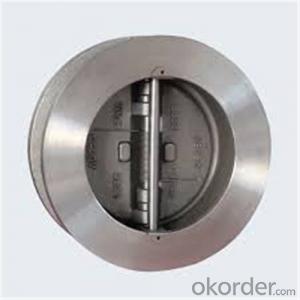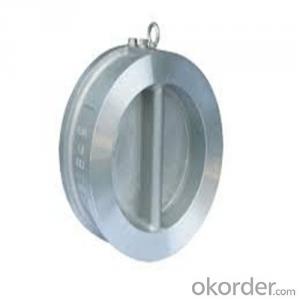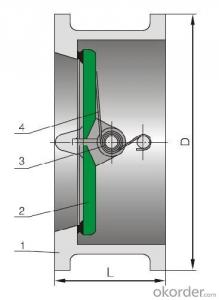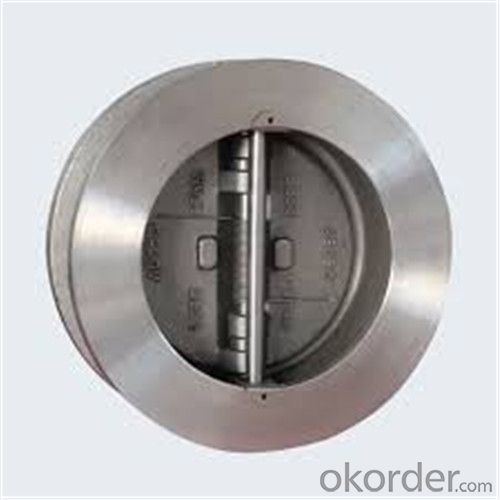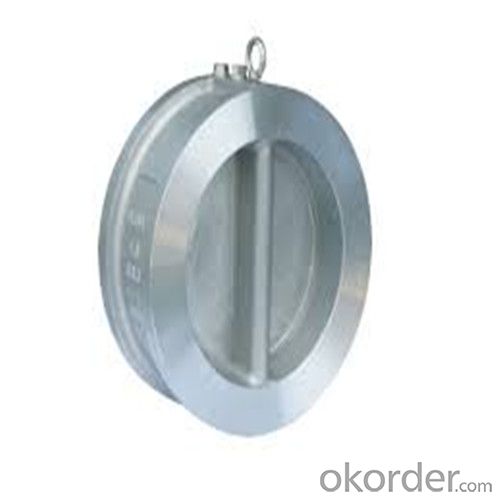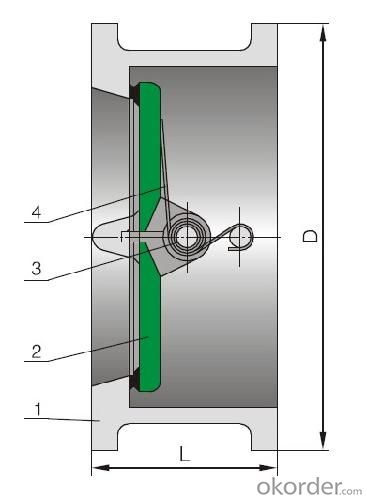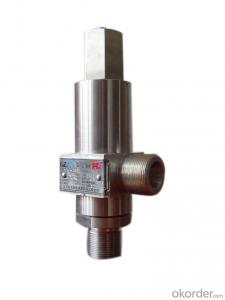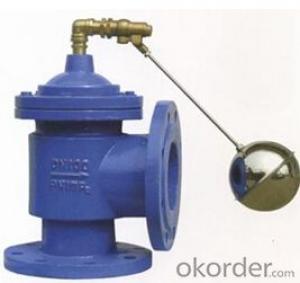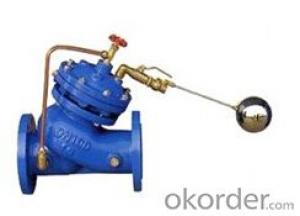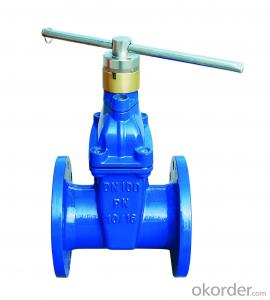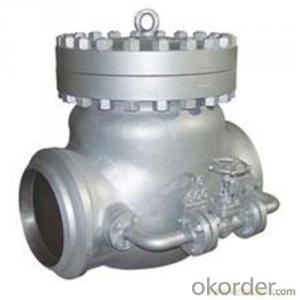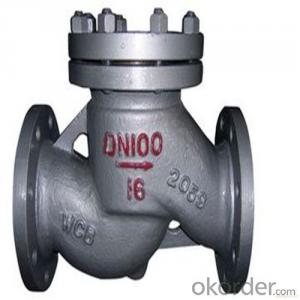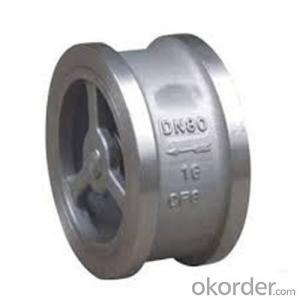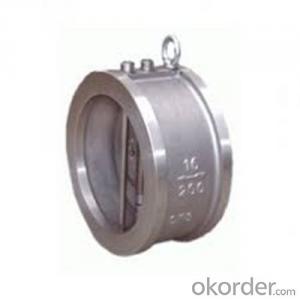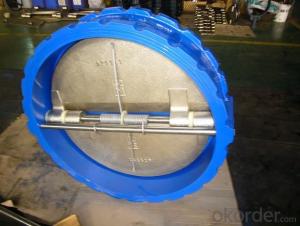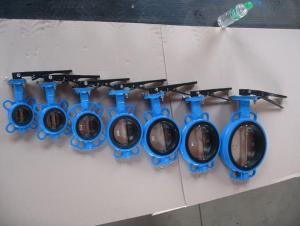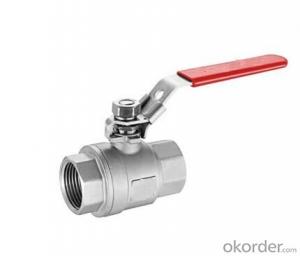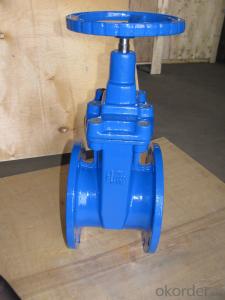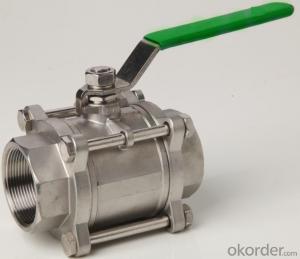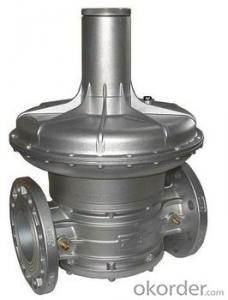Swing Check Valve Wafer Type Double Disc Body Material WCB
- Loading Port:
- Shanghai
- Payment Terms:
- TT OR LC
- Min Order Qty:
- 10 pc
- Supply Capability:
- 100 pc/month
OKorder Service Pledge
OKorder Financial Service
You Might Also Like
Products Description of Swing Check Valve
Check valves are used in pipes under pressures between PN1.6~16.0MPa(Class150~2500Lb), working temperatures-196~600℃, They are used in industries include oil, chemistry, pharmaceutical, fertilizer, and power gene-ration to prevent the backward flux of the media.
The main structure features of Swing Check Valve:
1、The products feature a reasonable structure, reliable seal, good performance and nice modeling.
2、Either soft or hard seal can be selected for the product upon different working conditions.The sealing face is built up with Co-based
carbide alloy, leaving a better wearability, corrosion and scrap resistance and a longer duration.
3、Small opening pressure, the disc can be opened fully with a very small pressure differential.
4、Inside-set bolt-bearing structure reduces leakage and reliable use.
5、PN≥16.0Mpa (class1500), the middle cavity uses a self-tightening sealing structure to have the sealing performance reinforced along
with the pressure rise so as to ensure the sealing performance.
6、Different parts materials and different sizes for flange, butt-welding are available for sensible combination according to different working facts and customers' requirements.
Parameter of Swing Check Valve:
Standard Criteria | GB customize |
Pressure Rating | 1 Mpa 1.6 Mpa 2.5 Mpa 4 Mpa 6.4 Mpa 10 Mpa 16 Mpa customize |
Valve Size | 50 mm 65 mm 80 mm 100 mm 125 mm 150 mm 200 mm 250 mm 300 mm 350 mm 400 mm 450 mm 500 mm 600 mm customi |
Actuator | Automatic customize |
Connection | Wafer customize |
Medium | Oil Steam Water customize |
Medium Temperature | -196~600℃ customize |
Structural style | Swing double-clack structure customize |
Application Fields | Agriculture Electricity Medical Petrochemical customize |
1-Body Material | CF3 CF8C CF8 WCB CF8M CF3M customize |
2-Disc | CF3 CF3M WCB CF8 CF8M CF8C customize |
3-Pivot | 1Cr13 1Cr18Ni9Ti 0Cr18Ni12Mo2Ti 2Cr13 customize |
4-Spring | 60Si2Mn 1Cr18Ni9Ti 4Cr13 0Cr18Ni12Mo2Ti customize |
Design Standard | GB/T 12224 customize |
Connection Standard | GB/T 9113 HG 20592 JB/T 79 customize |
Test Standard | JB/T 9092-1999 customize |
Face to Face | GB/T 15188.2-1994 customize |
Images of Swing Check Valve:
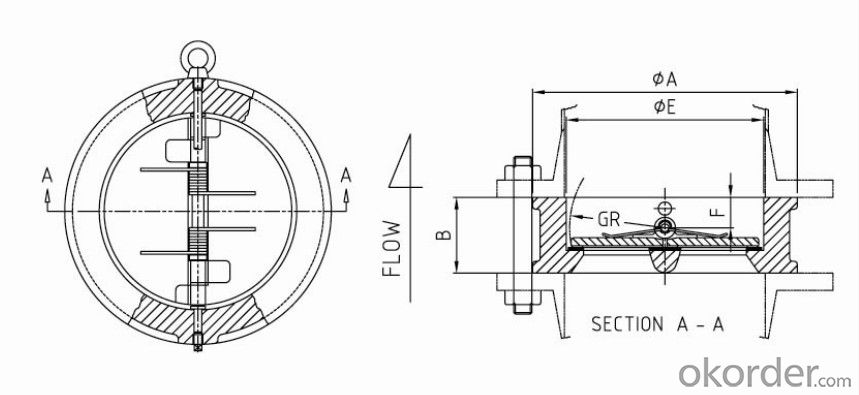
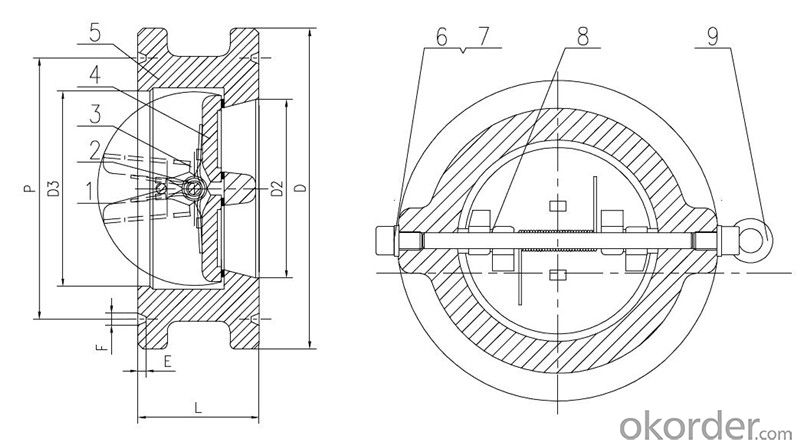
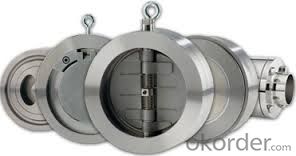
FAQ of Swing Check Valve:
Q1:I can’t find the type of steel check valve which I need. what can I do?
The chart above only lists out some common composition of steel check valve parts.We may provide other different parts material composition according to the customer's request or the actual valve working condition.
Q2:Which certification do your products pass?
Our products are in accordance with ISO 9001、ISO 14001、API 6A、API 6D、TS CE、API607/6FA/BS6755.
Q3:How can I place an order?
The only one thing you should do is to tell us the sepecification about type 、quantity and mode of transportation, then we will send you quotation within 24 hours.
- Q: Since the valve drain is usually open, I am wondering if placing the cap on the drain has made my water heater dangerous.
- Easy method, change washer in valve Right method: Turn off main , attach hose to existing valve, route out side to a point as lows with respect to furnace height, open valve and drain water, remove plastic valve. Sweat on new brass valve with torch, turn main back on or just keep bucket under to collect drips and finally Pressure will not build so the thing is not going to explode or any thing - i.e. you are safe E-mail me if you don't fully understand Joe
- Q: i went to the heart doc today to get the results from an echocardiogram and he told me i had two leakages in one of the valves of my heart. i dont know why, but i didnt even bother to ask him exactly what that meant because he told me it was nothing to worry about. can anyone tell me more about this?
- What okorder /
- Q: I want to reduce the prssure of a liquid flow (ethanol) from 16.7 atm to 1.2 atm? Do I need more than one valve?
- One control valve can reduce pressure, as long as there is always a significant flow through it. The main reason for using more than one valve is usually to reduce or prevent cavitation caused by a large pressure change through a given valve. Ethanol has a pretty high vapor pressure, so cavitation might be a problem. Control valve manufacturers usually provide design guides for their valve trim choices (often in software form) that lead you through the choices and requirements. Each valve design has different limits. But, my seat of the pants feel is that you can do this with one valve. I have included an example. I am not specifically recommending this company. -- Regards, John Popelish
- Q: ok so my 1993 bonneville started shaking and its smells like gas fumes in the car, so i cant drive it cause i have a newborn baby.so i took it to the dealership, they said codes 53,54,55,42,66 came up. they said i needed a new cadiletic converter, so i went to a local muffler shop. they said it was glowing cause it was so hot and said that wasnt the problem.i called the dealership back and they said they cleaned the egr vavle but said maybe it needs to be replaced, well before i spend any money i wanted to get everyones opinion, the car drive great, only shake when ur at idle. and smells awful inside uld this be the egr valve ?
- You most likely have a bad egr valve. The valve is stuck open, that is why the idle is so bad. In normal operation, the egr is never open at idle. The valve being open at idle causes the map sensor to misread the manifold vacuum. This make the computer dump extra fuel through the injectors. That make the catalytic converter overheat, because there is raw fuel going into it. You may have already ruined the converter, but you want to deal with the egr valve first, then see if the catalytic converter is bad.
- Q: I have a 98 Mitsubishi Mirage, seems there is a valve cover oil leak, i know this can be easily fixed by replacing the gasket.. but how will i know if the leak isn't from the valve cover gasket . Is the cylinder head gasket a major issue also .. if its not really the valve cover thats producing the oil leak should i not worry and just replace the valve cover gasket .?
- Sounds like you should clean your engine, then take a look to see where the leak is. Have you tried tightening the valve cover bolts?.
- Q: Is it safe to remove the butterfly valve on my 94 celica 1.8l st?
- Um...no Why would you want to? Also, a 94 celica should be fuel injected, and not have a butterfly valve. What do you call a butterfly valve? I call it a moveable plate that controls the air flow for the intake on a carburettor.
- Q: hello I am having trouble inflating my back wheel tube. so i guess i will just tell you what happened. well i came back from the bike shop with a presta valve adapter and i put it on my tube. it fills up too near full psi but just after a ride around the block it is flat. i have no idea why. please help me! also its a mavic tube 700 x 23, vittoria rubino pro 700 x 23 tire, and a vuelta xrp 17 deep v back wheel. thanks!
- OK, okorder /
- Q: im 28yrs old with two babies.in my heart two valves are very tight and leaking too,im going for a transplanting them in august.If there is anybody who got this problem solved please share.Thanks in advance.
- Usually with an artificial valve, you'll need to be on a blood thinner for the rest of your life. If they use a natural valve, you usually won't need the blood thinner - perhaps you will for a little while, but not permanently. You can request a natural valve, but the surgeon doesn't know what size/shape of valve you need until he actually opens you up and sees what he's working with. He has an idea, based on the x-rays and MRIs you've had done, but he won't know for sure until he actually see it. So the surgeons are going to request that the Organ Procurement Department to thaw out two or three valves, depending on what they see in the tests. You can't just keep thawing out valaves, testing them, and then refreezing them if they aren't what you are looking for, so if they turn out to not be a good fit, he's going to turn to an artificial valve. So you could request a natural valve, but because of the shape of the gap that he needs to fill, you may have to have an artificial valve. Blood thinners scare people, and your friends will tell you horror stories about how their uncle's cousin's Nephew cut his arm and bled to death because he was on a blood thinner! That could happen, but it is very rare. What does happen is that you will have to go to your doctor once a month and have a blood test, and if your blood is too thin, you need to ease off on the blood thinning medication. Or if it is too thick, you need to take more. If you're blood is too thin, you'll bruise more easily - which might be embarrassing if the bruise can be seen. Blood thinners aren't as dangerous as they make them out to be, but they can be inconvenient!
- Q: My check engine light is on in my 1999 Toyota Camry XLE...I went to autozone and they told me it was my egr valve BUT they did not tell me if it need to be cleaned or replaced. How can I tell if it needs to be cleaned or replaced
- its not an expensive part a new one will help mpg
- Q: Is what-valve spring. orvalve guide. orvalve cover. orretainer clip
- valve guide ase certified.
Send your message to us
Swing Check Valve Wafer Type Double Disc Body Material WCB
- Loading Port:
- Shanghai
- Payment Terms:
- TT OR LC
- Min Order Qty:
- 10 pc
- Supply Capability:
- 100 pc/month
OKorder Service Pledge
OKorder Financial Service
Similar products
Hot products
Hot Searches
Related keywords
